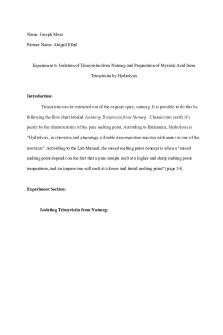Post lab - Post Lab 1 PDF

| Title | Post lab - Post Lab 1 |
|---|---|
| Author | So wa |
| Course | Organic Chemistry |
| Institution | University of Notre Dame |
| Pages | 2 |
| File Size | 45.4 KB |
| File Type | |
| Total Downloads | 100 |
| Total Views | 159 |
Summary
Post Lab 1...
Description
Waltrip 1 Sophie Waltrip 26 April 2018 Post Lab Report for Oxidation of Alcohol The product of cyclohexanone is pure because there were no extra peaks and all of the peaks that we were supposed to have showed up for both the C NMR and the IR. There is no peak on the cyclohexanone IR for the alcohol group, which was present in the reactants. There is a C=O group present which indicates that the correct product was formed. Also, on the CNMR for the product, there were 4 significant peaks for the 4 constitutionally inequivalent carbons which confirms the correct product. The reaction was efficient due to the purity of the product and the greener experiment methods. Sodium chloride and sodium sulfite are byproducts that can be washed down the sink after the experiment concludes which also makes it a more green experiment. The IR graphs were crucial in understanding how the peaks played a role in the purity of the product in relation to its reactants. Due to the presence of an OH functional group in the cyclohexanol and not in the cyclohexanone, there is a peak at 3321.05 on the cyclohexanol IR that disappears on the cyclohexanone IR. Cyclohexanone has an additional C=O bond that is not present in the cyclohexanol, which explains the presence of the peak at 1704.49 on the cyclohexanone IR. Also, there is a C-O group in the cyclohexanol IR shown by the peak at 1064.31 that is not present in the cyclohexanone. The C-H and C-H2 groups were conserved through the reactants and the products. This is shown through the almost equivalent peaks on both reactant and products. The peak for the C-H groups of cyclohexanol IR is longer than the peak of the C-H groups of the cyclohexanone IR because of the quantity of C-H groups in
Waltrip 2 cyclohexanol compared to cyclohexanone. Due to the relations of these peaks and the presence of some and not others, we can tell that the product is pure. The CNMR belongs to my products because of the 4 constitutionally inequivalent carbons. The peak on the far left signifies the carbon closest to the C=O group. The peak that is much farther from the first peak but still the most left of the bunch of peaks represents the carbons connected to the carbon previously mentioned. The peak next to this represents the third constitutionally inequivalent carbons. The rightmost peak that is close to the third peak represents the fourth constitutionally inequivalent carbon. It has similar characteristics to the third constitutionally inequivalent carbon, which explains its close proximity to the third peak, but they are still distinct carbons. Upon comparing this C NMR sheet to that of the reactants, we can tell that the product of cyclohexanone is pure....
Similar Free PDFs

Post lab - Post Lab 1
- 2 Pages

Experiment 1 post lab - Lab
- 1 Pages

Post lab 2 - post lab orton
- 8 Pages

Post lab 10 - Post lab 10
- 3 Pages

Post lab 3 - post lab orton
- 13 Pages

ORGO 2 POST LAB 8 - POST LAB
- 14 Pages

Lab 3 post-lab
- 2 Pages

Post-Lab 1 - assignments
- 1 Pages

Post Lab - lab report
- 2 Pages

Experiment 1 Post-Lab 1
- 10 Pages

Post lab 8 - lab 8
- 7 Pages

Post Lab Report Lab 5
- 5 Pages

Lab 5 Post-Lab Assignment
- 3 Pages

POST LAB 1 - Grade: A
- 2 Pages
Popular Institutions
- Tinajero National High School - Annex
- Politeknik Caltex Riau
- Yokohama City University
- SGT University
- University of Al-Qadisiyah
- Divine Word College of Vigan
- Techniek College Rotterdam
- Universidade de Santiago
- Universiti Teknologi MARA Cawangan Johor Kampus Pasir Gudang
- Poltekkes Kemenkes Yogyakarta
- Baguio City National High School
- Colegio san marcos
- preparatoria uno
- Centro de Bachillerato Tecnológico Industrial y de Servicios No. 107
- Dalian Maritime University
- Quang Trung Secondary School
- Colegio Tecnológico en Informática
- Corporación Regional de Educación Superior
- Grupo CEDVA
- Dar Al Uloom University
- Centro de Estudios Preuniversitarios de la Universidad Nacional de Ingeniería
- 上智大学
- Aakash International School, Nuna Majara
- San Felipe Neri Catholic School
- Kang Chiao International School - New Taipei City
- Misamis Occidental National High School
- Institución Educativa Escuela Normal Juan Ladrilleros
- Kolehiyo ng Pantukan
- Batanes State College
- Instituto Continental
- Sekolah Menengah Kejuruan Kesehatan Kaltara (Tarakan)
- Colegio de La Inmaculada Concepcion - Cebu

